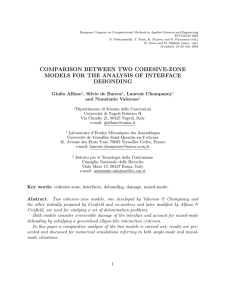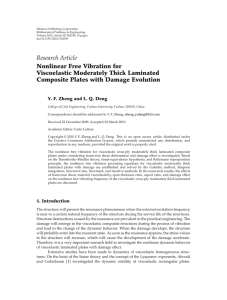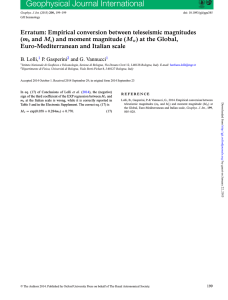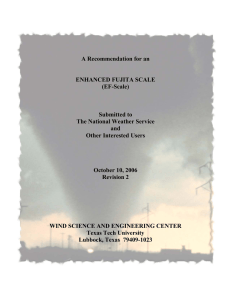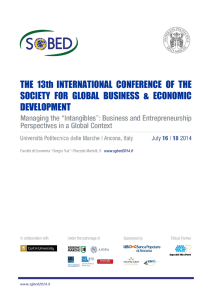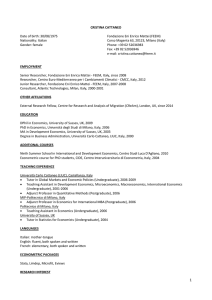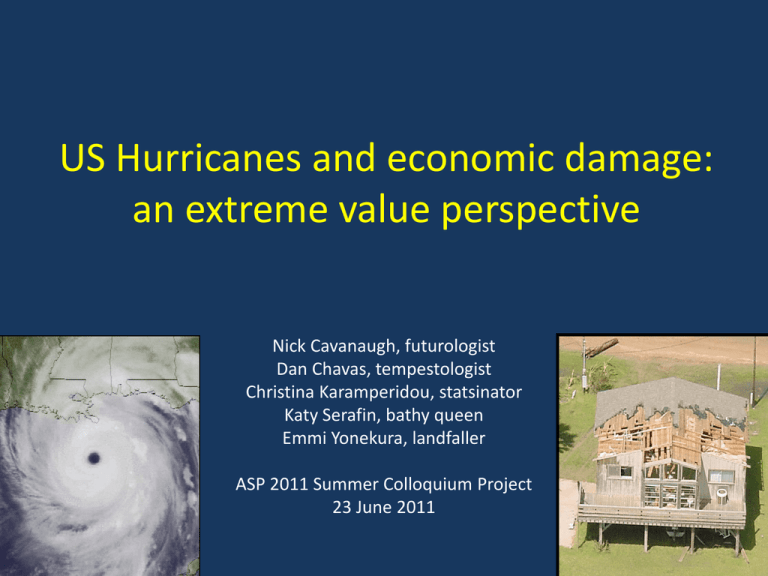
US Hurricanes and economic damage:
an extreme value perspective
Nick Cavanaugh, futurologist
Dan Chavas, tempestologist
Christina Karamperidou, statsinator
Katy Serafin, bathy queen
Emmi Yonekura, landfaller
ASP 2011 Summer Colloquium Project
23 June 2011
Outline
• Motivation
• Previous work
• Methodology and results
– Economic data: absolute vs. relative damages
– GPD without physical covariates
– GPD with physical covariates
– Application to GFDL current vs. future hurricanes
• Conclusions and future work
Motivation: society
GDP: 1o x 1o
Atlantic hurricane tracks (1900+)
(Yale G-Econ)
(NHC Best Track)
63% of global insured natural disaster losses caused by US landfalling hurricanes
(Source: Rick Murnane, last week)
http://gecon.yale.edu
http://gcaptain.com/wp-content/uploads/2010/09/Atlantic_hurricane_tracks.jpg
Motivation: science
• Objectives:
– Combine physical storm characteristics with
statistics of damages in an extreme value theory
framework
– Reduce the sensitivity of statistical analysis of
damage to economic vulnerability at landfall
Recent work
• Katz (2002), Jagger et al (2008,2011)
• Jagger et al (2008,2011): Generalized Pareto
Distribution (GPD) is appropriate for modeling
extreme events involving large economic
losses
However, inclusion of physical characteristics of storms as covariates has not been tried
Methodology I: absolute vs. relative damage
Economic data: Pielke et al., 2008
• Base year and normalized (2005$) economic damages
for 198 storms (pre-threshold) from 1900-2004
Histogram of Coastal GDP
60
50
40
Coastal Points
But are variations in damages representative
of the damage threat from a hurricane
or rather of the large variation in economic
value along the coast?
30
20
10
0
0
100
200
300
GDP
400
500
600
Distribution of GDP (bil $) in 1o x 1o boxes along US coast
Methodology I: absolute vs. relative damage
Physical characteristics of storms and economic value at landfall should be independent
Neumayer et al. (2011)
Physical
*
Economic
corr = -.1
Damage Index (DI)
Fraction of possible damage [0,1]
i.e. “damage capacity” of storm
Goal: remove from our damage database the variability in damages
due to variations in economic value along the coast
Results
Damages vs. DI: histograms
Histogram of Total Damage:
Histogram of Damage Index:
120
150
100
80
count
count
100
60
40
50
20
0
0
0
50
100
Total.Damage
Max = $150 bil
150
0.0
0.2
0.4
DamageIndex
Max = .89
0.6
0.8
Results
Damages vs. DI: no covariates
Damage Index (DI): [0,1]
Total Damage: (bil 2005$)
0.8
Bret
.89
0
0.4
0.0
0.2
50
Billion $
Damage Index
100
0.6
150
Great Miami
$156 bil
1900
1920
1940
1960
1980
Top 10 by Damage:
2000
1900
1920
1940
1960
Top 10 by DI:
1980
2000
Results
Damages vs. DI: no covariates
Damage Index (DI): [0,1]
30
28
29
Profile Log-likelihood
-148
-150
-152
Profile Log-likelihood
-146
31
-144
Total Damage: (bil $)
0.0
0.5
Shape Parameter
ξ>0
1.0
-0.2
0.0
0.2
0.4
Shape Parameter
ξ~0
0.6
0.8
1.0
Results
Damages vs. DI: no covariates
Quantile Plot
0
0.0
0.2
50
100
Empirical
0.6
0.4
Total Damage
Model
0.8
150
1.0
Probability Plot
0.2
0.4
0.6
0.8
1.0
20
60
80
Return
LevelPlot
Plot
Probability
Density Plot
Quantile
Plot
10
0.4
100
0.6
1000 1.0
0.8
ReturnEmpirical
period (years)
0.4
0.00 0.2 0.04
Empirical
f(x)
0.21
100
0.6
0.08 0.8 0.12
Model
0.6 0.8
1.0
80000
120000
0.1
0.0
40
Empirical
0.4
0 0.2 40000
Damage Index (DI)
Modellevel
Return
0.0
00.1
0.2 500.3
0.41000.5
x
Model
0.6150 0.7
Methodology II: physical covariates
Want to capture physical characteristics of individual storms that
are relevant to its capacity to cause damage
Hurricane Katrina
8:15p CDT
Aug 28 2005
Hurricane Katrina
8:15p CDT
Aug 28 2005
Eye
Hurricane Katrina
8:15p CDT
Aug 28 2005
Eyewall
Hurricane Katrina
8:15p CDT
Aug 28 2005
R34
Methodology II: physical covariates
Causes of damage
Wind
Sensitive to:
- Wind speed (Vmax)
- Size (R34)
Storm surge
Sensitive to:
- Wind speed (Vmax)
- Size (R34)
- Bathymetry (seff)
- Translation speed
- Landfall angle
See Irish et al. (2008)
http://myfloridapa.com/type%20of%20claims.html
Methodology II: physical covariates
• Wind speed Vmax: HURDAT Best Track 1900-2004
• Storm size R34: Extended Best Track (CSU) 1988-2005
• Bathymetry: gridded 1-min res altimetry data
100 km
seff
Methodology II: physical covariates
Bathymetry
Methodology III: GPD fit
PDF
-1-1/x
ì æ
ö
x
u
)
ï 1 ç1+ x (
÷
ïs è
s ø
P ( x x > u) = í
æ ( x - u) ö
ï 1
expç÷
ïî s
s
è
ø
,x ¹ 0
,x = 0
With Multiple Possible Covariates
lns = s 0 + s1Vmax + s 2 seff + s 3 r34
x = x 0 + x1Vmax + x 2 seff + x 3 r34
Results
Damage: with covariates
Damages
lns = s 0 + s1Vmax + s 2 seff
Residual Probability Plot
3
0.8
Likelihood - ratio test for s1 = 0 :
.62(.28)
2
Empirical
1
0.4
Model
0
ln .58(1.05) .015(.009) Vmax
0.2
u $5 billion(42pts)
0.0
p - value(seff ) = 0.79
0.6
p - value = 0.1
Likelihood - ratio test for s 2 = 0 :
4
1.0
x = x 0 + x1Vmax + x 2 seff
Residual Quantile Plot (Exptl. Scale)
0.0
0.2
0.4
0.6
0.8
1.0
0
Empirical
1
2
Model
Damage = f(Vmax)
*Using 1900-2004 data
r34 : not enough data
shape parameter left constant
3
Results
DI: with covariates
Damage Index
lns = s 0 + s1Vmax + s 2 seff
4
1.0
Residual Quantile Plot (Exptl. Scale)
Empirical
0
ln 2.650.64 0.010.005 Vmax 0.10.036 seff
0.10.17
2
3
0.8
0.6
1
u 0.06 (41pts)
0.4
(s 2 = 0) p - value = 0.02
(s1 and s 2 vs. s 2 ) p - value = 0.056
(s1 = 0, s 2 = 0) p - value = 0.003
0.2
Likelihood
-ratio test
(s1 = 0) p - value = 0.08
Model
x = x0
Residual Probability Plot
0.0
0.2
0.4
0.6
0.8
1.0
0.0
1.0
Empirical
2.0
3.0
Model
DI = f(seff, Vmax)
*Using 1900-2004 data
r34 : not enough data
shape parameter left constant
Methodology IV: Future Climate
• Statistical-Deterministic Hurricane model
(Emanuel et al. 2006)
– downscaled from GFDL CM2.0 model: 1981-2000
and 2081-2100 (A1b) climates
• Modeled values of Vmax and seff => GPD
Results: Future Climate
GPD PDF of US Hurricane Damage Index
Add all PDFs and
re-fit GPD for
each climate
6
0.4
0.3
density
4
model
density
5
model
0.2
A1B
ctrl
A1B
ctrl
3
0.1
2
0.0
0.5
0.6
0.7
DamageIndex
1
0
0.2
0.4
0.6
DamageIndex
0.8
1.0
0.8
0.9
1.0
Results: Future Climate
Local Distribution of Scale Parameter Change
Scale Parameter Shift
45
Δσlocal =Δ exp( σ0 + σ1Vmax + σ2seff)
0.04
40
0.03
0.02
lat
35
0.01
30
0
25
−0.01
−0.02
20
−100
−95
−90
−85
−80
lon
−75
−70
−65
Conclusions
• Damage Index, which seeks to remove economic
vulnerability from damages, appears to better
capture role of physical characteristics of storm in
causing damage than actual damages
• Bathymetry, wind speed found to be useful
covariates whose relationships are consistent
with physical intuition
• Changes in scale parameter in the future indicate
a shift to higher probability of extreme damage
events locally and globally, though we haven’t
proven differences are statistically significant
Future work ideas
• Find means of relating back to actual
economic damages
• Try rmax for size
• Account for uncertainty
• Try out a deterministic damage index and
apply GPD to that?
Thanks!
Comments/suggestions welcome
Results
Damages vs. damage index
Residual Quantile Plot (Exptl. Scale)
0
0.2
1
0.4
2
Model
Empirical
0.6
3
4
0.8
5
1.0
Residual Probability Plot
0.0
0.2
0.4
0.6
0.8
1.0
Empirical
0.0
1.0
2.0
Model
DI = f(seff)
3.0
Results
Damages vs. damage index
Residual Quantile Plot (Exptl. Scale)
2
0
0.2
1
0.4
Model
Empirical
0.6
3
0.8
4
1.0
Residual Probability Plot
0.0
0.2
0.4
0.6
0.8
1.0
Empirical
0.0
1.0
2.0
Model
DI = f(Vmax)
3.0
Results: Future Climate
0.012
0.010
density
0.008
model
A1B
control
0.006
0.004
0.002
0.000
50
100
vmax
150
0.6
0.5
density
0.4
model
0.3
A1B
control
0.2
0.1
0.0
2
4
6
8
gfdl.all$shelf
10
12
14
Top 10 by Wind Speed:
Example 1: Katrina vs. Camille
NOAA SLOSH model
KATRINA (2005)
Peak storm surge = 8.5 m
CAMILLE (1969)
Peak storm surge = 6.9 m
…yet Katrina produced much higher storm surge because it was twice as large
http://www.wunderground.com/hurricane/camille_katrina_surge.png
http://www.nhc.noaa.gov/HAW2/english/surge/slosh.shtml

